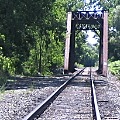- By Mark Johnson
- News
 Print
Print  The Department of Transportation (DOT) does not adequately monitor whether railroads in New York state comply with bridge inspection and reporting requirements or fully carry out its own bridge inspection responsibilities, possibly putting the public at risk, according to an audit released today by State Comptroller Thomas P. DiNapoli.
The Department of Transportation (DOT) does not adequately monitor whether railroads in New York state comply with bridge inspection and reporting requirements or fully carry out its own bridge inspection responsibilities, possibly putting the public at risk, according to an audit released today by State Comptroller Thomas P. DiNapoli.“The gaps in the railroad bridge oversight program uncovered by my auditors are troubling,” DiNapoli said. “DOT needs to do a better job making sure it’s on the same page with the railroads and the federal government so the public can be assured it is not in danger.”
DOT data shows there are currently 38 railroads that own or have maintenance responsibility for almost 3,000 railroad bridges in New York state. DOT has inspection responsibility for 48 of these bridges. DOT’s bridge inspection program is largely administered by just one employee, according to the audit.
DiNapoli’s auditors found that the bridge management plans DOT has on hand from the railroads are an average age of 10 years old and may no longer be relevant. Eight of the 38 plans (21 percent) were not dated, so auditors were unable to determine how current they were. In addition, DOT does not have any procedures to periodically follow up with the railroads to request current plans.
Four railroads did not submit actual bridge management plans. Instead, the companies sent correspondence stating they follow DOT’s requirements without sufficient details or documentation specifying how they do so. Of the remaining 34 plans on file, the majority were missing key pieces of required information. One small scenic railroad, the Cooperstown and Charlotte Valley Railroad, went nearly 17 years without a bridge management plan in place from the time it was acquired in 1996 until 2013.
DOT does not have a complete inventory of all railroad bridges in the state including all data elements required by state regulations. For the 2,946 railroad bridges listed in the database’s total inventory, auditors found that more than 90 percent do not include the date of the last general inspection or the date of the last load rating calculation. In addition, visits to four railroads showed that the database was missing at least 103 bridges and contained 23 other structures miscoded as bridges.
DOT also does not actively monitor the submission of inspection certifications by the railroad companies. As a result, four of 114 certifications due during the audit period of Jan. 1, 2010 to June 30, 2013 were not submitted, 43 were late and 63 did not contain the bridges’ most recent general inspection date. None listed diving inspection dates on over-water bridges for which they were required.
Furthermore, DOT did not monitor whether inspections were done on the 48 bridges it is responsible for. As a result, eight required inspections were not done between 2010 and 2012.
Auditors also found DOT has not coordinated with the Federal Railroad Administration (FRA), which has a similar bridge management program, to determine how these agencies can share information and otherwise reduce potential duplication of effort.
v9i47



